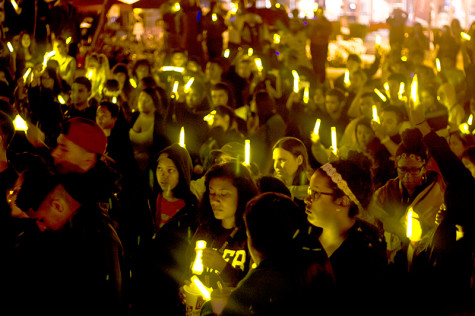Finding the way back to normal
October 30, 2014
Oakland holds Antoinette Harris’ heart for many reasons; it’s where she spends her time hiking, where she attends church, where she raised her daughter, where she was diagnosed with breast cancer, and where she beat breast cancer.
After four years of remission, 12 years ago, Harris volunteered with her daughter for the first time at the Susan G. Komen’s “Race for the Cure,” a 5k run that raises money for the Breast Cancer Movement. Harris continues to work with the organization.
Although she still helps out with the race, her role in the foundation has changed. She now educates at tabling events where she provides information for schools, gives speeches about being a survivor, and works on grant committees.
As the end of October nears, it also marks the end of National Breast Cancer Awareness Month. Harris urges that although October is Breast Cancer Awareness Month, “breast cancer doesn’t disappear the other 11 months out of the year.”
According to www.komen.org, “The risk of getting breast cancer increases as you age.” Although breast cancer is not preventable, Harris suggests, “One thing that helps is early detection. Know your breasts! Routine self-examinations are important because it’s better to catch anything early on. ”
It wasn’t about the chemo, or how it would affect my body. I knew I could handle that. What really worried me was breast conservation.
— Harris
Harris said knowing her body is the reason why she is alive today. Fifteen years ago, the Friday after Thanksgiving, Harris had just stepped out of the shower and noticed a red spot on her right breast. Her immediate reaction was, “maybe the shower was too hot?” After a few hours of prodding the discolored, rigid lump, she decided to go to the doctor the next morning.
The doctor did not provide an answer that she wanted right away. Harris went through multiple mammograms, two biopsies and finally a sonogram. After almost three months of tests and waiting, she was diagnosed with stage three breast cancer.
So what was the next step? Harris knew the plan of action; first she would have surgery then move on to chemotherapy, but knowing the facts did not calm her nerves about the surgery.
“It wasn’t about the chemo, or how it would affect my body. I knew I could handle that. What really worried me was breast conservation,” she said.
Harris was hopeful that she would be able to have a lumpectomy – the removal of the tumor and surrounding cancerous tissue.
“For me it was like, I would look down at my breast, and I would think ‘okay, from here to there just cut that piece out and I’ll be fine,” said Harris.
But after talking to her surgeon, he explained that a mastectomy – removal of all breast tissue – would be best considering the size and depth of the tumor.
After her surgery she had eight rounds of chemotherapy, a treatment that uses chemicals to kill fast-growing cells in the body.
“The first two weeks of chemo was a breeze! It was the weeks three through eight that I became tired, nauseous and I would have a lack of appetite. But it was all manageable,” she said.
One of the hardest things for Harris to come to terms with was losing her breast. The option of having reconstructive surgery was available, but the risks of going through a voluntary surgery were just too high for her.
Instead, she found a new appreciation for her body that she didn’t have before. “It was no longer ‘I have to get dressed up and go get milk at the store, it was a new reality of – yeah, I have one breast, but I’m alive,’” said Harris.
It’s been 16 years since Harris was diagnosed, but it was not until nine years ago that she started to feel like her old self. She explains, “chemo zaps everything, all the bad stuff and all the good stuff. It took seven years to really feel like I got back to what was me.”
Harris says that people often associate cancer with a death sentence, but she insists it does not have to be. She attributes her recovery to faith and being aggressive in taking care of her health.
“The earlier you detect that there is something wrong the better. Cancer is not the death sentence; the death sentence comes when you do not follow up. The people who detect and follow up with treatment are the ones who save their lives.”
The moment it feels like something is wrong, ask questions. Breast cancer does not discriminate. According to the Susan G. Komen foundation, breast cancer affects 1 in 8 women every year.
CSUEB Health Center is equipped to advise students who have questions regarding their health. They also have counseling available to students who may be struggling with the toll it takes on a someone who has been or has a family member who has been diagnosed with cancer.
For more information on how to volunteer or donate check out ww5.komen.org. For more information on the different types of cancer and the treatments involved visit, http://www.cancer.org.



